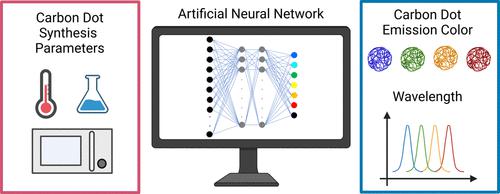当前位置:
X-MOL 学术
›
J. Chem. Inf. Model.
›
论文详情
Our official English website, www.x-mol.net, welcomes your feedback! (Note: you will need to create a separate account there.)
Machine Learning-Assisted Carbon Dot Synthesis: Prediction of Emission Color and Wavelength
Journal of Chemical Information and Modeling ( IF 5.6 ) Pub Date : 2022-11-17 , DOI: 10.1021/acs.jcim.2c01007 Ravithree D Senanayake 1 , Xiaoxiao Yao 2 , Clarice E Froehlich 2 , Meghan S Cahill 2 , Trever R Sheldon 2 , Mary McIntire 2 , Christy L Haynes 2 , Rigoberto Hernandez 1, 3
Journal of Chemical Information and Modeling ( IF 5.6 ) Pub Date : 2022-11-17 , DOI: 10.1021/acs.jcim.2c01007 Ravithree D Senanayake 1 , Xiaoxiao Yao 2 , Clarice E Froehlich 2 , Meghan S Cahill 2 , Trever R Sheldon 2 , Mary McIntire 2 , Christy L Haynes 2 , Rigoberto Hernandez 1, 3
Affiliation

|
Carbon dots (CDs) have attracted great attention in a range of applications due to their bright photoluminescence, high photostability, and good biocompatibility. However, it is challenging to design CDs with specific emission properties because the syntheses involve many parameters, and it is not clear how each parameter influences the CD properties. To help bridge this gap, machine learning, specifically an artificial neural network, is employed in this work to characterize the impact of synthesis parameters on and make predictions for the emission color and wavelength for CDs. The machine reveals that the choice of reaction method, purification method, and solvent relate more closely to CD emission characteristics than the reaction temperature or time, which are frequently tuned in experiments. After considering multiple models, the best performing machine learning classification model achieved an accuracy of 94% in predicting relative to actual color. In addition, hybrid (two-stage) models incorporating both color classification and an artificial neural network k-ensemble model for wavelength prediction through regression performed significantly better than either a standard artificial neural network or a single-stage artificial neural network k-ensemble regression model. The accuracy of the model predictions was evaluated against CD emission wavelengths measured from experiments, and the minimum mean average error is 25.8 nm. Overall, the models developed in this work can effectively predict the photoluminescence emission of CDs and help design CDs with targeted optical properties.
中文翻译:

机器学习辅助碳点合成:发射颜色和波长的预测
碳点(CD)由于其明亮的光致发光、高光稳定性和良好的生物相容性而在一系列应用中引起了广泛关注。然而,设计具有特定发射特性的CD具有挑战性,因为合成涉及许多参数,并且尚不清楚每个参数如何影响CD特性。为了帮助弥补这一差距,这项工作采用了机器学习,特别是人工神经网络来表征合成参数对 CD 的发射颜色和波长的影响,并对其进行预测。该机器表明,反应方法、纯化方法和溶剂的选择与CD发射特性的关系比实验中经常调整的反应温度或时间更密切。在考虑多个模型后,性能最佳的机器学习分类模型相对于实际颜色的预测准确率达到 94%。此外,结合颜色分类和通过回归进行波长预测的人工神经网络k集成模型的混合(两阶段)模型的性能明显优于标准人工神经网络或单阶段人工神经网络k集成回归模型。根据实验测量的 CD 发射波长评估模型预测的准确性,最小平均误差为 25.8 nm。总体而言,这项工作中开发的模型可以有效预测 CD 的光致发光发射,并帮助设计具有目标光学特性的 CD。
更新日期:2022-11-17
中文翻译:

机器学习辅助碳点合成:发射颜色和波长的预测
碳点(CD)由于其明亮的光致发光、高光稳定性和良好的生物相容性而在一系列应用中引起了广泛关注。然而,设计具有特定发射特性的CD具有挑战性,因为合成涉及许多参数,并且尚不清楚每个参数如何影响CD特性。为了帮助弥补这一差距,这项工作采用了机器学习,特别是人工神经网络来表征合成参数对 CD 的发射颜色和波长的影响,并对其进行预测。该机器表明,反应方法、纯化方法和溶剂的选择与CD发射特性的关系比实验中经常调整的反应温度或时间更密切。在考虑多个模型后,性能最佳的机器学习分类模型相对于实际颜色的预测准确率达到 94%。此外,结合颜色分类和通过回归进行波长预测的人工神经网络k集成模型的混合(两阶段)模型的性能明显优于标准人工神经网络或单阶段人工神经网络k集成回归模型。根据实验测量的 CD 发射波长评估模型预测的准确性,最小平均误差为 25.8 nm。总体而言,这项工作中开发的模型可以有效预测 CD 的光致发光发射,并帮助设计具有目标光学特性的 CD。



























 京公网安备 11010802027423号
京公网安备 11010802027423号